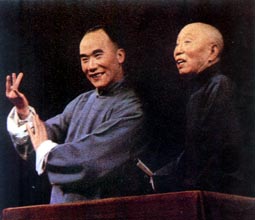 Xiangsheng (Comic Dialogue) is one of the most popular and influential types ofquyi. It can be said that nobody in China does not know or like it. It is humorous and highly satirical by nature. Though similar performances had been popular for centuries, it was only in the reign (1851-1861) of Emperor Xianfeng of theQing Dynastythat xiangsheng became established as an independent art form.
Xiangsheng (Comic Dialogue) is one of the most popular and influential types ofquyi. It can be said that nobody in China does not know or like it. It is humorous and highly satirical by nature. Though similar performances had been popular for centuries, it was only in the reign (1851-1861) of Emperor Xianfeng of theQing Dynastythat xiangsheng became established as an independent art form.
The first xiangsheng artists were Zhang Sanlu and Zhu Shaowen, the latter's stage name being Qiong Bupa.
Qiong used to perform in the entertainment quarter ofBeijingknown as Tianqiao. He always began with a ragged verse that started and ended with the same word (something like a palindrome phrase). Then he imitated the street hawkers' peculiar cries and sang some ancient songs. As the audience grew, he started his proper xiangsheng item. His stage name originated from a poem inscribed on a pair of bamboo clappers (a kind of percussion instrument) that he had used. The words on the clapper were, "Eating by begging from many houses and sleeping in ancienttemples. Never do anything against the law, and don't be afraid of seeing the emperor." Zhu's four apprentices all had similar-styled stage names.
Zhu and his two contemporaries, A Yantao and Shen Chunhe, formed the three earliest big categories of xiangsheng artists who passed on their skills to their disciples. Now, after over a century's development, xiangsheng art has ushered in its eighth generation of artists.
Since the late Qing Dynasty and the early years of the ROC, xiangsheng art has made great advances in content and skills, and representative artists have emerged in different periods.
For instance, in the late Qing period a group of artists whose names all contained the character "de" arose, including Yu Delong, Jiao Dehai, Zhou Deshan, and so on. People called them the Eight "Des" of Xiangsheng.
There were Li Dexi with the stage name of Wan Renmi and Zhang Shouchang (and his style of art) during the ROC period. After the founding of the PRC, talented artistsHou Baolin,Ma Sanli,Ma Jiwho was Hou's student, and Ma Ji's studentJiang Kunall displayed highly distinctive skills and have become very famous artists.
There are three forms of xiangsheng.
The earliest form was performed by one person, and was called Dankou xiangsheng. Its contents were mostly jokes and humorous stories.
Later, Duikou xiangsheng or "cross talk," performed by two people, appeared. One man was called Duogen, and the other, Penggen. When A is the primary talker while B chimes in, this is called yitouchen (heavy-at-one-end), and the subject of argument between them is called zimugen. Recitals and narration are called guankouhuo, and imitations of opera songs and words are called huhuo.
The third form of xiangsheng performed by three or more people is called Qunkou xiangsheng. It calls for one artist to say funny things, while others chime in and yet another makes them stray from the subject. Of the three forms, cross talk is the most popular and widespread.
